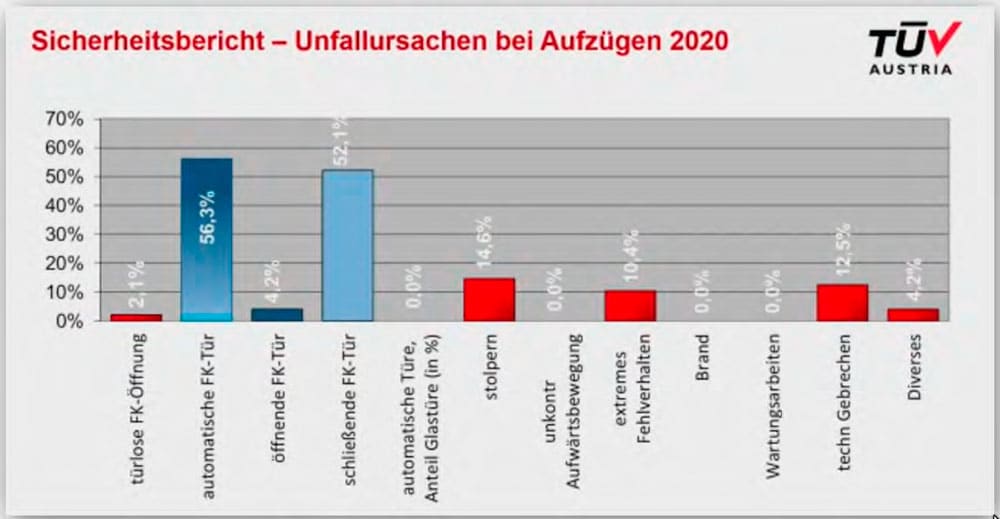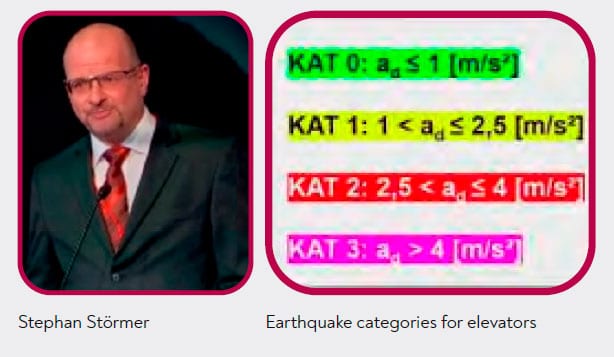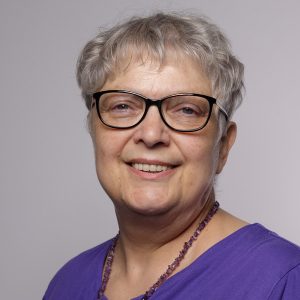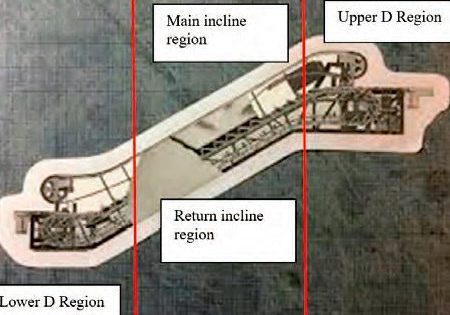Vienna gathering offers mixture of new topics and familiar concepts.
In April, the 20th TÜV AUSTRIA Lift Day took place, for the second time, optionally online or in the Museum Quarter Wien Arena 21. Approximately 100 participants (65 online and 35 present) took part. In best times at the Vienna City Hall, the conference had up to 400 participants. This year onsite, because of the pandemic, a strict FFP2 mask obligation was applied, along with proof of a valid negative COVID test and strict recognition of social-distancing rules. As always, the event offered a mixture of new topics and an update of familiar concepts. The focus was on elevator safety.
Mag. (FH) Karin Newald from TÜV AUSTRIA Academy, who also led through the day, welcomed the audience. Mag. (FH) Christian Bayer, TÜV AUSTRIA Academy, opened the event. Specifically, he urged online viewers to use chat intensively to create encounters. He called for the generation that is now in training to be provided with the same opportunities as before the pandemic. He sees everyone on duty to offer something and to pass on knowledge in the spirit of mentoring. The conference was closed by Ing. Thomas Maldet from TÜV AUSTRIA, who traditionally also gave the first presentation of the day, with the words: “Please stay healthy!”
“Current Developments in the Elevator Sector”
This was Maldet’S focus topic. He looked back over 20 years. While elevators are still going up and down, in the past, for example, landing accuracy was more of a coincidence or, in emergency situations, there would be a ring, but no one came. Today, a car will stop with a precision of millimeters, and you will have a voice connection in seconds if you activate the emergency call. In the meantime, however, he said he sometimes asks himself whether we are overdoing it with digitization in some instances. After all, we are still transporting people and, therefore, people should also handle the overall situation on site. “People protect people!” is his motto, he said.
“We are living in an uncertain world,” Maldet observed. “For each of us, life ends fatally.” What we will be doing in between is up to ourselves. Threats like the pandemic, plane crashes, train crashes, climate change and more cybercrime exist. The safest mode of transportation in the world, according to search engines, is an airplane, followed by cable cars, trains, buses and cars. The most dangerous part of air travel is the car ride to the airport. The elevator, however, has been overlooked here. In some magazines, the elevator is mentioned in a solitary message as safe.
Current important basic conditions of elevator operation are:
- Users’ need for safety: Technical safety is assumed.
- Laws and standards versus overregulation
- Surveillance versus privacy and data protection
- Digitization: Monitoring and remote intervention
- Hygiene: Pollution and vandalism, aerosols in the cab, viruses on push buttons
Safe installation and operation of elevators are regulated by ASV 2015. §4 deals with bringing products to market, making them available on the market and commissioning.
ÖNorm (short for Austrian standard) EN 81-20 regulates, among other things:
- Intended use, but also misuse, by children or loads
- Constructional problems such as building law, reinforcement or outdoor stops
- Operating sites such as when earthquakes occur — also in Austria
A new addition is the impact of COVID-19 on elevator operations. One year later, there is no end in sight to restrictions. Volker Lenzner asked about this in the chat: Are additional disinfection devices in the elevator not to be seen as non-elevator equipment? Maldet stated that it is makeable if it is necessary for safe operation. However, it is necessary to check whether one creates new problems, such as less space or hot air.
In terms of compliance with requirements, Maldet specifically pointed to the elevator operation and maintenance manual, in addition to following laws and standards. He called them “the most underrated documents in elevator operation. As an operator, look in it! There are things in there that are important to you.”
The part of his talk that draws the most attention is always the safety report; see graphs and interview.
“Risk Factor Earthquake: Are We Safe in an Elevator?”
Ing. Stephan Störmer, also from TÜV AUSTRIA, explored the topic of earthquake safety from the previous year in a more in-depth manner. The trigger for this was the strongest quake of the past 20 years in Austria on March 30.
The harmonized ÖNorm EN 81-77:2019 specifies categories 0 to 3 for elevators subject to earthquakes. Various factors determine the assignment to a category. Their determination is sometimes difficult:
Reference floor acceleration: See ÖNorm B 1998-1 with tabulated values per single federal states
- Behavior coefficient for non-load-bearing components according to ÖNorm EN 81-77 and ÖN EN 1998-1
- Significance category of the building type I to IV, e.g., residential buildings according to ÖNorm EN 1998-1
- Ground classes A-E, according to ÖNorm EN 1998-1
- Importance coefficient depending on life-saving measures in ÖNorm EN 1998-1, e.g., a leaflet of the Vienna building police
- Charge heights with definitions Z and H, according to Vienna building police. An interpretation of EN 81-77 is in progress. Definition: Upper reference point of Z is the height level of the mass center of gravity of the relevant elevator part, e.g., the car. H to be coordinated with building planner or structural engineer if necessary. It may make the difference between category 0 and 1.
- Determination of oscillation times Ta = 0 if the elevator does not affect the basic oscillation period of the building. Applies to normal buildings. See ÖNorm EN 1998-1 and Vienna building police.
New elevators in existing Eurocode 8 buildings are problematic because the oscillation behavior is uncertain and, thus, the effects on the elevator are unknown. Nevertheless, MD applies because earthquakes are considered to be foreseeable. The EN 81-77 standard does not apply, but should be considered.
For instructions and examples on how to determine the parameters for determining the earthquake category, see the information letter from the Vienna building police at wien.gv.at/wohnen/baupolizei/pdf/aufzug-erdbebenkategorie.pdf (in German language only). This cannot be automatically applied in other federal states, but the procedures will still help. The application may have to be discussed with the authority.
Kevin Landrichter asked in the chat: Does EN 81-77 also have to be taken into account for home lifts? Störmer answered that the standard is not mandatory, but the MD applies. The seismic risk must be considered, and the standard gives guidance on what to consider and how to proceed. David Serafin asked in the chat, what about values Z and H for sloped sites? Störmer recommended that for a rough design, one should assume the most unfavorable Z to H and act according to building planner/structural engineer guidance for an exact design.
COVID-19 – Update, Organization and Technology
The three aforementioned aspects were dealt with in a concentrated manner by three lectures. Mag. Jürgen Schlechter from the NBC Defense Center of the Austrian Armed Forces spoke on “Pandemic & Prevention: An Update.” His institution has performed more than 400 pandemic missions between March and December 2020, from reprocessing of FFP2 protective masks via advising health authorities, GOs, NGOs, companies, compilation of hygiene and prevention concepts, disinfection measures up to the area-testing concept. The goal is to achieve as much safe standard operation in a company as possible by means of hygiene.
Schlechter recommends establishing pandemic officers in the company. He advises adding larger safety margins to company concepts so they do not have to be constantly adjusted, e.g., a 2-m distance from day 1 instead of just 1 m. Clear instructions for action, e.g., a maximum of 10 persons per room X, create trust. Employees must be trained, because a notice on the management bulletin board is insufficient; a hygiene policy is more than checklists on the intranet.
His summary was: The current situation will continue until at least 2022. Currently, there is a “race for vaccines against mutations.” He describes acceptance of testing as already quite good. Reaching increasing vaccination acceptance is the goal. As a long-term goal, he suggested a combination flu/COVID-19 vaccine, which, in a current combination, is refreshed every year.
“Organizational Solutions in the Elevator Sector” was presented by Ing. Philippe Wanzenböck from TÜV AUSTRIA. He dealt with reducing passenger numbers via notification of passengers and cleaning. Parking the elevator with the doors open as a preventive measure to combat viruses depends on many factors, e.g., whether reprogramming is possible at all or whether fire protection requirements within the building are permitted. It may be necessary to have the elevator inspector check for about 200 € as to whether open parking is possible, which is then documented in an inspection report.
“Technical Solutions in the Elevator Sector” was presented by Christoph Oppitz MA from KONE at the conclusion of the conference. The current user need is for availability and cleanliness. Among other things, he presented air purifiers and handrail sanitizers. Surfaces can be coated or taped/foiled as a hygiene measure. UV radiation is used in the empty cabin; cleaning robots also already work with UV-C light. Infotainment systems inform people in the waiting area and in the car. He describes the elevator’s full-load limit setting as relatively inaccurate because, for example, it cannot distinguish between one adult or two children. His conclusion: “The hygiene market is dynamic.”
Ulrike Lotze asked in the chat how high the risk of infection in the elevator actually is. The speakers agreed that there is no simple answer to this question because of the many influencing factors such as use, organization, cleaning and ventilation.
Get more of Elevator World. Sign up for our free e-newsletter.














